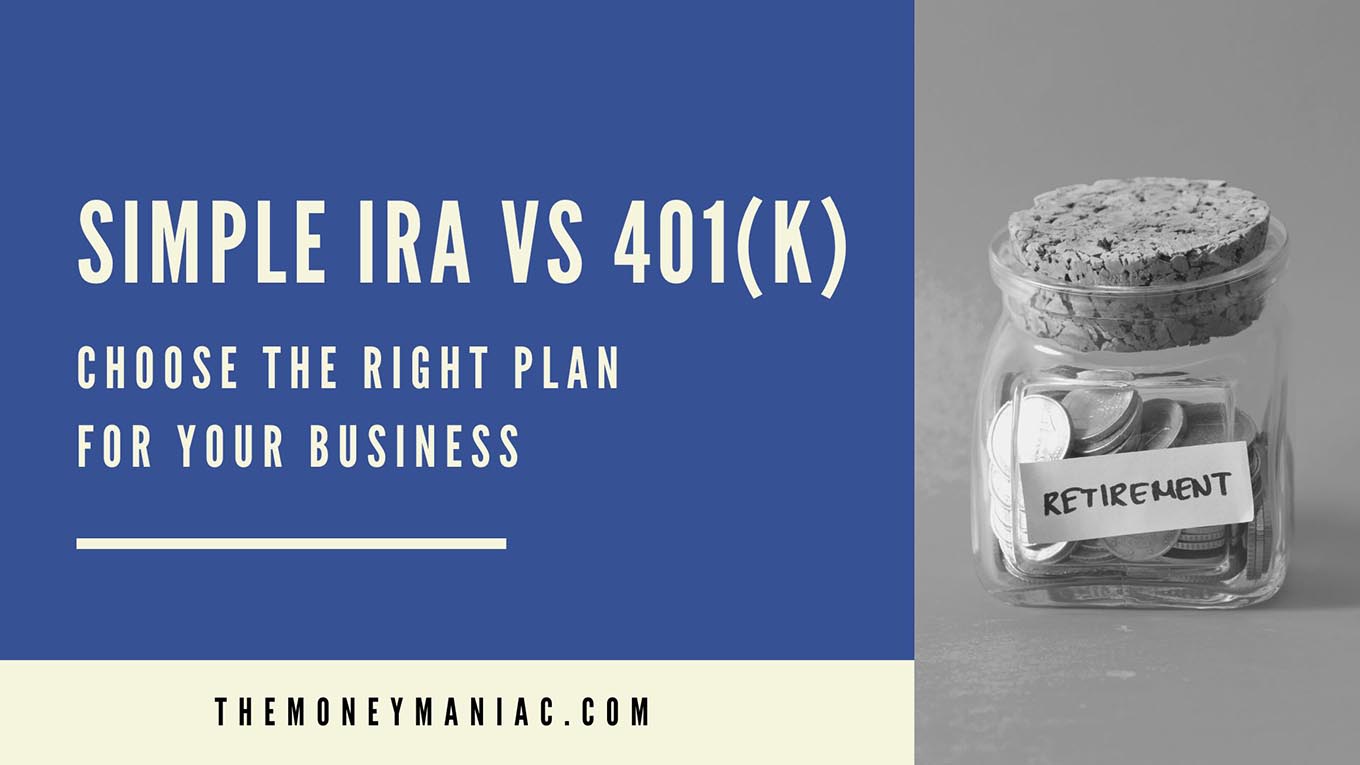Choosing a retirement plan for your small business can be overwhelming. There are many options available, and each of them varies based on cost, employee eligibility, contribution limits, contribution requirements, and more.
To determine what’s best for you and your business, it’s important to compare two of the most popular retirement plans on the market: the SIMPLE IRA vs 401k.
This article will highlight the differences between these options, and help you decide how to move forward with your benefits planning.
What is a Simple IRA?
A SIMPLE IRA plan, also known as the Savings Incentive Match PLan for Employees, is a *simple* way for small employers to offer retirement benefits. This retirement plan consists of two types of contributions: a mandatory employer contribution and an optional employee salary reduction contribution.
What is a 401(k)?
A traditional 401(k) plan is a retirement savings plan that is more complex but more flexible than a Simple IRA.
For small business owners, one of the key distinctions between the two is that 401(k) plans do not mandate matching employer contributions like Simple IRAs do. However, if the employer does decide to make matching contributions, they must do so by the deadline of the business’s federal income tax return including any extensions.
Simple IRA vs 401k: The key differences
When deciding between the Simple IRA vs 401k for your business and your employees, consider the following differences:
Eligibility requirements
Both plans require employees to be at least 21 years old.
To maintain a SIMPLE IRA, employers must have 100 or fewer employees. And to qualify for inclusion, employees must have earned at least $5,000 from the employer during any two previous years and reasonably expect to make at least $5,000 in the current year. Employers can reduce these requirements, but cannot impose more stringent requirements.
For a 401(k), employees must have been with the company for at least one year to be eligible to contribute.
Employer contributions
With the Simple IRA, employers must either match all voluntary employer contributions (capped at 3% of the employee’s compensation) or offer a nonelective contribution of 2% of each eligible employee’s pay.
With the 401(k), employers are not required to make any contributions. If they choose to do so, however, the total contributions cannot exceed the employee’s annual pay.
Contribution limits
According to IRS guidelines, the Simple IRA will have a salary reduction contribution limit of $15,500 in 2023 ($16,000 in 2024). And if the employee is 50 years old or older, they can make additional catch-up contributions of up to $3,500 in 2023 and 2024.
With 401(k) plans, employees are allowed to save up to $22,500 in 2023 ($23,000 in 2024). And if the employee is 50 years old or older, they can make additional catch-up contributions of up to $7,500 in 2023 and 2024.
The overall limit for 401(k) contributions, including both employer and employee contributions is $66,000 in 2023 ($69,000 in 2024) and $73,500 with catch-up contributions ($76,500 in 2024).
Fees
In general, it doesn’t cost anything to establish a Simple IRA account. Some providers may charge an annual maintenance fee, but these tend to be no more than $30 per account. Accounts with a qualifying balance may even have the maintenance fee waived entirely.
The initial fee to start a 401(k) account ranges from $500 to $2,000. Plus, there may be plan administrative fees like in a Simple IRA.
If the cost of establishing a retirement plan has been holding you back, you are in luck. The SECURE Act expanded one tax credit and established another to offset these costs for small businesses that meet three simple criteria.
Administrative requirements
The Simple IRA does not have any annual tax filing requirements, which makes it easier for employers to manage. However, plan details must be sent to employees on an annual basis.
A 401(k) plan, on the other hand, is required to conduct compliance tests to ensure that the plan does not favor any particular employee. Depending on the size of your organization, this can create a larger administrative burden as compared to the Simple IRA.
Summary
| 2024 Summary | Simple IRA | Traditional 401(k) |
|---|---|---|
| Eligibility Requirements | Up to 100 employees | No size restrictions |
| Employer Contributions | Two matching options | No matching required |
| Employee Limits | $16,000 | $23,000 |
| Fees | Maintenance only | Setup and maintenance |
| Admin Requirements | Annual plan details | Nondiscrimination test |
How to choose the right plan for your business
Now that you understand the main differences between the Simple IRA vs 401k, it’s time to decide which retirement plan is right for you and your employees. Here are a few considerations to take into account:
Eligibility requirements
As a small business owner, are you looking to provide yourself, your key employees, or all of your employees with retirement savings options?
By default, a Simple IRA requires a longer minimum service period than a 401(k), which can be beneficial depending on your goals. But if you’d rather cover all of your employees immediately, the Simple IRA offers you the flexibility to reduce these requirements as desired.
Employer contributions
Determine how feasible it is to make employer contributions to the retirement accounts of all your eligible employees. Keep in mind that this can be an additional perk or it can be used in lieu of higher compensation.
If it is possible, either plan can be suitable for your needs. But if an employer contribution is not in the cards immediately, the 401(k) plan offers more leeway in this regard.
Industry
Consider any industry-specific practices when it comes to choosing a retirement plan for your small business. If most of your competitors offer dollar-for-dollar match via the Simple IRA or the higher contribution limits of a 401(k) plan, you may find yourself at a disadvantage if you don’t follow suit.
Check with the local Department of Labor or any industry associations to learn more about how other businesses in your sector are thinking about retirement funds.
Employee count
If you have more than 100 employees, only a 401(k) plan will cover your business. If you have fewer than 100 employees, either workplace retirement plan is an option. But if you have a very small team, the minimal administrative requirements of a Simple IRA may be preferable.
Company location
When evaluating a Simple IRA vs 401k, always research any state-specific mandates you may be subject to.
For example, some states may require employers to match employee contributions. In this case, the reasoning to choose a 401(k) may no longer be valid.
Other states may provide additional tax incentives for setting up a Simple IRA or offer other retirement savings options altogether.
Investment flexibility
With a Simple IRA, plan participants have access to a full suite of investment options including stocks, bonds, ETFs, and more. Whereas in a 401(k), employees generally have a more limited selection of mutual funds.
Decide whether your employees value flexibility or simplicity. While a Simple IRA may offer more choices, it can also overwhelm less savvy investors by providing less direction.
Costs
401(k) plans usually cost more to put in place. If you are looking to save money, a Simple IRA may be more budget-friendly in year one.
On an ongoing basis, the two retirement plans have comparable maintenance fees. However, the administrative cost of maintaining a 401(k) plan could be higher if you have to pay for fiduciary services to meet its more stringent regulations.
Other retirement plan options
Aside from the Simple IRA and 401(k) plans, there are several other retirement options that may suit your business. These include the SIMPLE 401(k), SEP IRAs, Solo 401(k), Profit Sharing Plans, and Cash Balance Pension Plans.
Each of these retirement plans offers its own unique features and benefits. Let’s take a quick look at each plan to see which one might be right for your business.
Simple 401(k)
The Simple 401(k) is only available to employers with 100 or fewer employees. This plan is easier to manage than a traditional 401(k) but does not allow employers to maintain any other qualified retirement plan.
In order to participate, employees must be at least 21 years old and have one year of completed service. Employees covered by a Simple 401(k) plan can allocate a portion of their wages to the plan.
Unlike a traditional 401(k), employers must make a either matching contribution or a non-elective contribution. These employer contributions are subject to the same limits as a Simple IRA, which scale with the employee’s annual compensation.
Simple 401(k) plans also allow for hardship withdrawals and participant loans. These features are beneficial to employees but can add a layer of administrative complexity when used.
SEP IRA
A business of any size can establish a Simplified Employee Pension (SEP) plan, which enables the employer to contribute to employees’ traditional Individual Retirement Accounts (IRAs).
In order to be eligible for a SEP IRA, employees must be at least 21 years old and have worked for the employer for three of the last five years. They also must have earned at least $650 in compensation in the previous year.
The contribution limit for a SEP IRA is the lesser of 25% of the employee’s annual compensation and $66,000 in 2023 ($69,000 in 2024).
This plan is easy and cheap to establish, but it requires the employer to contribute to all employee accounts equally. For this reason, it is most frequently adopted by self-employed individuals.
Solo 401(k)
The solo 401(k) is designed for self-employed individuals or small businesses with no full-time employees. Other than the business owner’s spouse, the IRS does not allow any other employees to participate in the plan.
Solo 401(k) plans offer a lot of flexibility and can be set up as either traditional or Roth retirement funds. Roth plans do not offer tax-free deductions, but all distributions, including earnings, are tax-free.
The contribution limit for solo 401(k) plans is $66,000 in 2023 ($69,000 in 2024). And if the “employee” is 50 years old or older, they can make additional catch-up contributions of up to $7,500 in 2023 and 2024. However, these total annual contribution limits are broken into two buckets and are subject to more complicated rules than other plans.
To open a solo 401(k), you will need an employer identification number (EIN). Then, contact a financial institution that offers one-participant 401(k) plans and complete the account application and adoption agreement.
As long as you maintain no common-law employees, there is no required discrimination testing and almost no administrative upkeep. Plus, you will be able to invest in every type of investment that your broker offers.
Profit Sharing Plan
Any business, no matter its size, can establish a profit-sharing plan — even if the company already has a qualified retirement plan. These plans allow the employer, but not the employee, to make discretionary contributions to an employee’s retirement account. For this reason, it is essentially a 401(k) plan minus the employee contributions.
In a profit-sharing plan, the employer contribution can vary from year to year based on company performance, and the company does not necessarily have to turn a profit to make a contribution. However, the employer must establish a formula for how profit-sharing contributions are made.
The most popular way to calculate how to share profits among employees is the comp-to-comp ratio. First, the company determines the total compensation of all its employees. Then, the company calculates what percentage of the profit-sharing plan an employee is entitled to by dividing their individual compensation by the total compensation pool.
Finally, multiply each employee’s compensation percentage by the total amount of profit being shared among all team members.
Cash Balance Pension Plans
A cash balance pension plan is a type of defined benefit pension plan in which participants have the option to receive their benefits as a lump sum or an annuity. Like a defined contribution retirement plan, this type of retirement plan is maintained at an individual level.
In cash balance pension plans, employers credit a participant’s account each year with a fixed percentage of the employee’s yearly compensation, plus interest charges.
If the employee elects to receive their benefits as an annuity, they are protected from all changes in the portfolio. Whether the company’s investments turn a profit or a loss, the employer still has to fund the plan each year according to the terms of the agreement.
Cash balance pension plans are popular among business owners because of their high contribution limit. While the exact limit varies based on age and annual income, those over 60 years old can often deposit more than $200,000 in pre-tax earnings. This greatly reduces their tax liability and quickly bulks up their retirement savings.
Related reading: How To Claim The ERC Tax Credit
Final thoughts
Retirement planning is an important part of both your personal and professional financial strategies. Whether you’re building an ecommerce business, scaling an existing company, or launching a franchise, understanding the differences between a Simple IRA vs 401(k) can help you and your team reach financial freedom faster.
If you have already decided how to structure your company, then shift your attention to establishing a retirement plan. By working through our decision criteria above, you should be able to determine the best match for the unique needs of your business.



